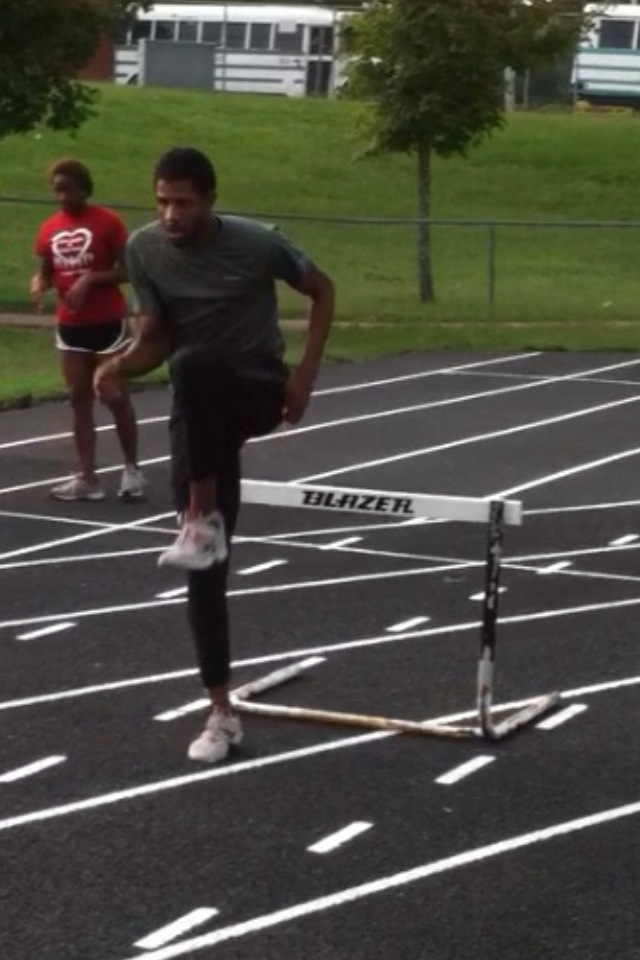Keeping the Hips Up
When people ask me about how to keep the hips up while hurdling, I usually answer that I don’t think so much in terms of keeping the hips up, but in terms of not allowing the hips to drop. There are two key moments when the hips will potentially drop if you’re doing something wrong: during take-off, and upon landing.
[am4show not_have=’g5;’]
[/am4show][am4guest]
[/am4guest][am4show have=’g5;’]
During Take-off:
The key at take-off into the hurdle is to stay on the ball of the foot. Hurdlers who have a background in the long jump, triple jump, or high jump will “plant” that last step, or stomp, which will send them in more of a vertical direction. In the jumping events, the plant step enables the athlete to elevate. While planting, the hips drop, and then they push back up when the athlete is airborne. In hurdling, you don’t want that vertical element in the hips. In hurdling, you want the hips to push forward horizontally, although smaller hurdlers may need a slight vertical element to ensure clean clearance of the barrier. By staying on the ball of the foot instead of planting, the hurdler allows him or herself to keep the momentum moving forward, and the hips can stay tall and keep moving horizontally as the legs go up and over the barrier.
Many hurdlers who plant instead of staying on the ball of the foot do so because their last stride into the hurdle is too long. Hurdlers want to employ what is commonly referred to as a “cut step,” which is the last step prior to take-off. This step should be shorter than the previous stride so that the hurdler can push forward through the hurdle, keeping the hips tall. If this stride is too long, and/or if the foot lands in front of the hips instead of under the hips, the hurdler’s hips will drop, making the hurdler smaller and the hurdle higher. Some three-steppers who are still at a stage in their development where they’re still happy just to make it to the hurdles in three strides tend to hurdle this way. Instead of lifting their knees and attacking the track with each stride, they reach with the foreleg. Doing this enables them to cover the necessary ground, but it also causes their hips to drop. Then, of course, the hips drop even more with the stride into the hurdle.
Upon Landing:
During descent off the hurdle, the lead leg must cycle back under the hip. If the lead leg stops cycling, but instead floats down to the track, the hips will drop when the foot of the lead leg touches down. A lot of coaches tell their athletes to run on their toes, which is not good advice, although I understand where it comes from. “Run on your toes” is supposed to mean, “don’t run flat-footed” and “don’t run on your heels.” But if you are literally running on your toes, that means your toes are pointing down; the ankle is plantar-flexed (toes pointing down) instead of dorsi-flexed (toes pointing up). The difference is huge. When running on your toes, your hips will drop with every stride, because your toes cannot support your weight. When running on the balls of your feet, your hips will stay tall. And when it comes to touching down off the hurdle, you will have a seamless return to sprinting between the hurdles, with no dropping of the hips.
Since the key to keeping the hips tall is running tall on the balls of the feet, here are some drills that can help with that:
- A-Marches
- A-Marches over cones
- A-Skips
- High Knees
- Hurdle Marches
- Quick 3-step drill
 In the above photo, my athlete is doing A-Marches over cones. The cones serve the purpose of being a “hurdle” so that he can do the marches to the hurdle rhythm; they also force him to emphasize lifting the knee, keeping the ankle dorsi-flexed, and driving the hips forward.
In the above photo, my athlete is doing A-Marches over cones. The cones serve the purpose of being a “hurdle” so that he can do the marches to the hurdle rhythm; they also force him to emphasize lifting the knee, keeping the ankle dorsi-flexed, and driving the hips forward.
 Here, my athlete does A-marches over hurdles, or what I like to call “hurdle marches.” Three steps between each hurdle, and then the stride over the hurdle. Again, hurdle rhythm is developed, and the athlete focuses on staying tall on the balls of the feet while driving the hips forward.
Here, my athlete does A-marches over hurdles, or what I like to call “hurdle marches.” Three steps between each hurdle, and then the stride over the hurdle. Again, hurdle rhythm is developed, and the athlete focuses on staying tall on the balls of the feet while driving the hips forward.
In the video above, an 80 meter hurdler does hurdle marches over low hurdles. I took the bar off the top and laid it against the bottom part, so that the bar is about 24 inches high. This particular athlete habitually runs on his heels, so the marches help to break him of this habit and to get in the habit of landing on the ball of the foot and keeping the hips tall. Then, he moves on to the next stage of development. After effectively executing the A-marches, now he can do the quick-three-step drill, speeding things up a bit and focusing on the same principles.
[/am4show]
